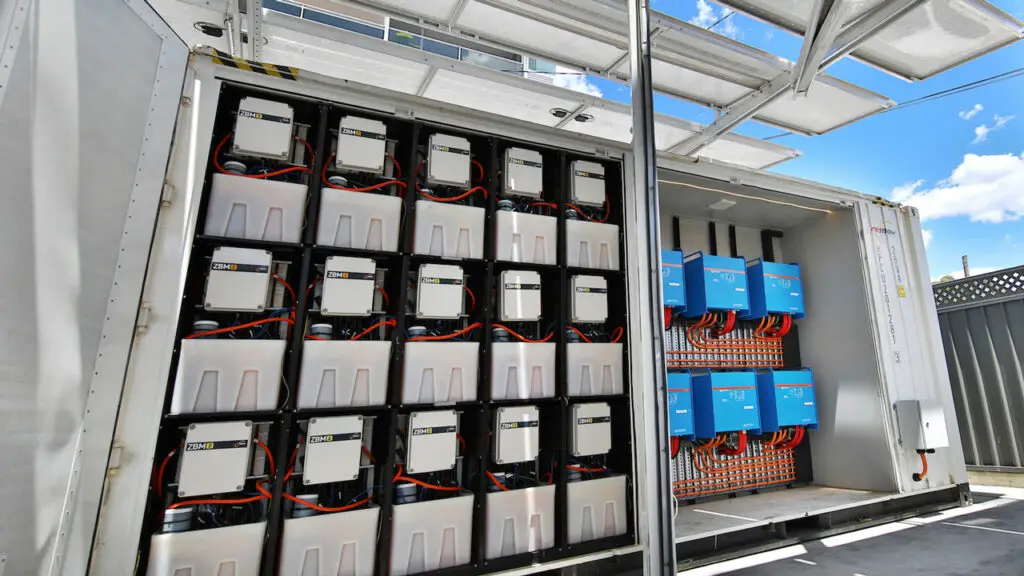Soalr batteries come in various chemistries, each with its own set of characteristics, advantages, and limitations. Flow batteries differ from other types of rechargeable solar batteries in that their energy-storing components—the electrolytes—are housed externally in tanks, not within the cells themselves.
The size of these tanks dictates the battery’s capacity to generate electricity: larger tanks mean more energy storage.
For example, with solar panels or wind turbine setups, the electrolyte in the “positive” tank is energized through oxidation at the anode.
This energy is transferred to the electrolyte in the “negative” tank, connected to the cathode, via a reduction process.
The exchange of ions happens in compartments on either side of a special membrane that keeps the tanks separate.
To produce electricity, the charged electrolytes are pumped past this membrane, allowing electrons to flow back into the original tank, creating an electrical current that can be harnessed for power.
What Is Flow Battery and How Does It Work?
A flow battery is a rechargeable battery with energy from two liquid chemicals separated by a membrane.
These chemicals, dissolved in liquids, flow through the battery in separate loops.
Electricity is generated or stored when ions move between these liquids through the membrane, with the flow of electricity happening in an external circuit.
The amount of energy a flow battery can store depends on how much liquid there is, while the size of the electrodes determines the power it can generate.
These batteries can be categorized into inorganic and organic types, and within these, they can be full-flow, semi-flow, or membranes.
One key difference from regular batteries is that in flow batteries, the energy isn’t stored in the solid electrode materials but in the electrolyte liquids.
Flow batteries can be operated similarly to fuel cells, or they can be recharged with electricity, allowing the liquids to be used repeatedly.
They have advantages like the ability to scale energy and power independently and a long lifespan.
However, they are not as energy efficient as some other batteries, typically only 50-80% due to losses from the internal movement of the liquids and the need for larger, costlier stacks to compensate.
Moreover, they are generally heavier than lithium-ion batteries because the electrolyte is liquid and requires solvents.
Applications for Flow Batteries
Flow batteries present a noteworthy option for managing energy within electrical grids and microgrids, as well as a potential alternative for electric vehicle power systems.
Utilities and Electrical Grids
Flow batteries are attractive to utilities due to their ability to discharge over longer periods—up to 10 hours—compared to other commercial batteries that typically offer one to two hours of discharge.
This capability is particularly beneficial in balancing the irregular supply of electricity from renewable sources and the fluctuating demand, such as the increased need for air conditioning during hot weather.
By using flow batteries, utilities can avoid producing excess energy and mitigate stress on grid infrastructure.
Microgrids
Microgrids operate on a smaller scale and can function independently from the central grid.
Flow batteries could be advantageous in microgrid setups due to their longevity and ability to provide energy during periods when it’s not feasible to produce enough power locally or when energy from the grid is costly.
Electric Vehicles (EVs)
For electric vehicles, the rapid “recharging” capability of flow batteries—by simply replacing the electrolyte liquid—could offer a quick turnaround solution at “refueling” stations compared to the longer recharge times required for lithium-ion batteries.
Nonetheless, the currently lower energy density of flow batteries limits their practicality for EVs, as it would result in a reduced driving range.
Researchers are exploring ways to increase this density, but for now, the adoption of flow batteries in EVs remains a more distant possibility.
Flow Batteries vs. Lithium-ion Batteries
When considering the suitability of flow batteries versus lithium-ion batteries for specific applications, the key differences lie in safety, longevity, physical footprint, cost, and power density:
Safety
Flow batteries are generally safer because they use non-flammable electrolytes, such as vanadium solutions, which are less likely to catch fire compared to the electrolytes in lithium-ion batteries.
Additionally, the design of flow batteries allows for the electrolyte tanks to be stored separately from the power stack, increasing their overall safety.
Longevity
Vanadium flow batteries boast a lifespan of up to 30 years, largely because they avoid the phase-to-phase chemical reactions that degrade materials over time, unlike lithium-ion batteries, which may last for about 8 years with daily cycling.
Physical Footprint
Flow batteries require large tanks for the electrolytes, taking up significant space, whereas lithium-ion batteries have a much smaller physical footprint due to their higher energy density and compactness.
Cost
The cost of flow batteries tends to be higher due to the need for larger electrodes and separators to accommodate their lower charge and discharge rates, in addition to the extra components such as pumps and plumbing.
Lithium-ion batteries have reached a mature market stage, benefitting from economies of scale that lower their cost.
Power Density
Lithium-ion batteries have a higher power density, making them capable of delivering large amounts of energy in a short period (1 to 2 hours).
Flow batteries have a lower power density but can supply a steady flow of energy for extended periods (up to 10 hours), making them ideal for applications where a long-duration energy supply is needed.
The “winner” in the comparison between flow and lithium-ion batteries depends on the specific needs of the application.
Flow batteries excel in safety, longevity, and sustained energy supply, whereas lithium-ion batteries are superior in terms of portability, cost, and short-duration high-power delivery.








